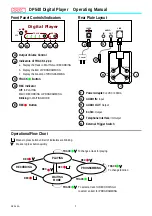
LIF200 User Manual
25
Download
- To receive a file transmitted over a network. In a communications session, download means
receive, and upload means transmit.
Dynamic IP Address
- An IP address that is automatically assigned to a client station in a TCP/IP
network, typically by a DHCP server. Network devices that serve multiple users, such as servers and
printers, are usually assigned static IP addresses.
Ethernet
- IEEE standard network protocol that specifies how data is placed on and retrieved from a
common transmission medium. Has a transfer rate of 10 Mbps. Forms the underlying transport vehicle
used by several upper-level protocols, including TCP/IP and XNS.
DDNS (Dynamic Domain Name System)
- Allows a network device with a dynamic Internet IP address
to have a fixed host and domain name, such as
myhostname.mydomainname.com
. It is useful when you
are hosting your own website, FTP server, or other server behind a router, so people can find your site no
matter how often the Internet IP address changes. Using DDNS requires registering with a DDNS service
provider on the Internet.
DHCP (Dynamic Host Configuration Protocol)
- A protocol that lets network administrators centrally
manage and automate the assignment of Internet Protocol (IP) addresses in an organization's network.
Using the Internet‟s set of protocols (TCP/IP), each machine that can be connected to the Internet needs a
unique IP address. When an organization sets up its computer users with a connection to the Internet, an
IP address must be assigned to each machine. Without DHCP, the IP address must be entered manually
at each computer and, if computers move to another location in another part of the network, a new IP
address must be entered. DHCP lets a network administrator supervise and distribute IP addresses from a
central point and automatically sends a new IP address when a computer is plugged into a different place
in the network. DHCP uses the concept of a “lease” or amount of time that a given IP address will be
valid for a computer. The lease time can vary depending on how long a user is likely to require the
Internet connection at a particular location. It‟s especially useful in education and other environments
where users change frequently. Using very short leases, DHCP can dynamically reconfigure networks in
which there are more computers than there are available IP addresses. DHCP supports static addresses for
computers containing Web servers that need a permanent IP address.
DNS
- The Domain Name System (DNS) is the way that Internet domain names are located and translated
into Internet Protocol (IP) addresses. A domain name is a meaningful and easy-to-remember “handle” for
an Internet address.
Domain
- A sub network comprised of a group of clients and servers under the control of one security
database. Dividing LANs into domains improves performance and security.
Firmware
- Code that is written onto read-only memory (ROM) or programmable read-only memory
(PROM). Once firmware has been written onto the ROM or PROM, it is retained even when the device is
turned off.
Full Duplex
- The ability of a device or line to transmit data simultaneously in both directions.
Gateway
– A device that interconnects networks with different, incompatible communications protocols.








































